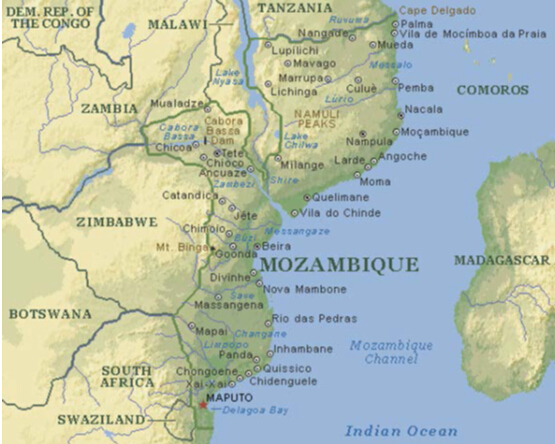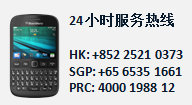Mozambique

Ports Information Update
All the ports in Mozambique are owned by CFM (Caminhos de Ferro de Mozambique).Many of the ports have been given to private companies to manage the ports as going concerns. However, all the property in the port is owned by CFM on behalf of the Mozambique state.
There have been no reported attempted piracy attacks in the region. The waters are patrolled by the South African and Mozambique Navies.
There have been no reported Ebola cases in Mozambique. We believe that they will simply follow South African guidelines should a case be reported.

Pemba
The harbour of Pemba is very small, however is situated in a sheltered bay. The port is managed by CFM. The bay/ area of Pemba has potential for being a deep water port.
The entrance channel is approximately 23 meters in depth but alongside the berth the depth is only 6.4 to 7.6 meters.
Pilotage is compulsory and there is no tug assistance. There is only one berth which is 182 meters in length, and this berth is used for both oil /gas and general cargo and supply vessels.
There are limited fenders along the berth and therefore arriving vessels should take care during berthing operations.
There are limited / minor cargo claims at the port of Pemba but nothing of great concern.
Normal security should be in place. We have not had reports of stowaways attempting to board in Pemba.
In the summer months crews should be aware of malaria.
Nacala
Nacala or Nacala-Porto is on the northern coast of Mozambique and is the deepest natural port on the east coast of Africa. It serves as the terminal for the Nacala Railway, a rail link to the landlocked Malawi.
Pilotage at Nacala port is compulsory, and with ships being boarded 2 miles from the Nacala lighthouse. The port is managed by Portos Do Norte SA who supply all port services including stevedoring.
The fendering in the port is poor and arriving vessels should be mindful of the poor fendering.
We have experienced claims in the past for damage to the quayside and for bollards being pulled out from mooring ropes. This is generally due to the lack of proper maintenance.
We receive the usual cargo claims in this port arising from bagged cargoes like rice/ cement/ and fertiliser. We have noted rough handling of cargo by stevedores and then the receivers allege shortages. Majority of the local receivers will accept Clubs LOU’s in the event of a security demand, which in turn will allow the vessel to sail from the port in due course.
Recently, we have noted a number of disputes with bulk sugar loaded in the port. The cargo is railed/trucked to the port in jumbo bulk bags which in turn are drained into the cargo holds as bulk cargo and we have experienced a number of quantity disputes between shore and draught survey figures.
There are no shore scales in Nacala, and therefore the bags are NOT being weighed prior to loading. The bags are alleged to weigh 1 ton (net) weight and they simply carry out a tally to determine cargo quantity.
The weight of the jumbo bags could have changed during the transportation from Malawi to Nacala, and furthermore whilst in storage within the port warehouse.
Majority of the Receiver’s will accept Clubs LOU’s in the event of a security demand.
We have also noted bulk food cereals being discharge in Nacala into hoppers and the cargo then bagged and weighed. Again, shortage disputes arise between ship and shore figures.
In the summer months crews should be aware of malaria.
Normal security should be in place. We have not had reports of stowaways attempting to board in Pemba.
Beira
The port of Beira in Mozambique is situated at the mouth of the Pungue River at Longitude 34º 50' E and Latitude 19º 51' S. The port is operated by Cornelder.
Access to the port is obtained via the dredged Mancuti Channel (17 n.miles from the Mancuti lighthouse). Ships waiting for berthing instructions are required to anchor east of the outer channel.
The port is tidal with a MH spring range of 6.2 - 7.4m.
Vessels awaiting berth must anchor at the bar. The approach to the River Pungue is obstructed by numerous banks and shoals, which are constantly changing. Master should obtain an update on the banks / shoals from the Pilots / Port Authorities / Agent upon arrival at Beira. Vessels have grounded in various locations during the approach to the port, but have refloated on higher tides. Masters should exercise caution when transitting the buoyed channel.
From the north end of Channel Rambler, the entrance channel is marked by light buoys west of Cbadelo light (metal mast, 4m in height), exhibits 9 cables north northwest of Ponta Gea on the edge of a bank fronting the shore between Ponta Gea and Ponta Chiveve.
The port is open 24 hours a day although night navigation is restricted to vessels up to 7m draught and LOA of 140m. Pilotage and tug assistance is compulsory at all times, with pilots joining ships near P Buoy.
Vessels with a draught of 4.88m or less may enter the port at any state of the tide. Those drawing more than 4.88m are required to wait for a suitable height of tide before entry.
During the raining season which in turn will result in a high river, the ebb stream can attain a rate of up to 6 knots at springs and 2 - 4 knots at neaps.
We receive the normal cargo claims from bagged items like rice/ cement/ fertiliser). These can be shortage claims based on B/L and shore tally. We also receive damages claims caused by stowage and rough handling by stevedores. Majority of the local receivers will accept Clubs LOU’s in the event of a security demand, which in turn will allow the vessel to sail from the port.
We recommend that draught surveys are carried out for bulk cargoes in order to protect members/ clubs interest should any shortage claim arise.
Beira has been turned into a coal export port and a lot of money has been spent on upgrading the port. Loading coal in Beira is restricted because of the berth and channel depths and the LOA of a vessel
The draft limitation at the coal terminal berths only allow vessels to load to certain draft depth. Thereafter, the vessel will proceed to anchorage, where two self-loading ships with offset cranes will top up with cargo, allowing the vessel to load to the maximum draft and contract weight.
The STS operation is carried out off shore and ships should be aware to exercise the usual cautions for STS operations and to check that there is adequate fendering in place. Please do not forget the stern of both ships.
Certain STS operations of liquid cargoes also occur off Beira and again the usual STS precautions should be in place.
There have been a few knocks/vessel making contact during the the STS operations. Many of these occurred in the initial start-up of the STS operation in Beira a few years ago and have tapered off now. We have not had a reported incident for over a year now which indicates that the operation has improved and that proper mooring masters are in use and proper fendering available. This does not mean that the master of your member's vessel can let his guard down and he should be mindful at all times. The incident referred to above was between two tankers and it occurred 3 months ago. The incident can be put down to the wrong positioning of fenders.
The security within the port is reasonable, however the crew / master should remain on a “high” security level. Members are recommended to have normal gangway and deck watches. Crew should be mindful of going ashore as we have heard reports of single crewman being mugged and robbed, best option is to travel in groups.
In the summer months crews should be aware of malaria.
MAPUTO
The port of Maputo is the main and the busiest port of Mozambique. It is also a river port which is subject to large tidal fluctuations. The Port of Maputo consists of two main port areas.
The first part is the city area which is managed by MPDC. The second part of the port is in Matola, and this part is controlled by CFM and consists of the bulk cereal terminal, the alumina terminal, the liquid terminal and the coal terminal.
There is one access channel from the open sea leading into Maputo Bay, the North Channel with a limiting depth of 11m (Canal do Norte). The channel passes to the North of Portuguese Island (Ilha dos Portugueses) and is well marked by light buoys.
The distance from the North Channel entrance at Buoy 1N to the Pilot Station at Buoy 6 is 25 miles. From the Pilot Station at Buoy 6 the Xefina, Polana and Matola Channels lead into the quaysides and terminals.
We have investigated and attended to numerous vessels that have grounded having left the buoyed channel.
We have received numerous reports and concerns about the condition of the port and the depths alongside the various berths.
With regard to the latter, the port of Mozambique has just signed an agreement with Transnet in South Africa to carry out proper dredging of the port. Berths will be properly dredged in order that ships can load the agreed tonnages.
When ships are loading and discharging bulk cargoes, we recommend that a draught survey is carried out to prevent shortage claims.
Iron ore is loaded in Maputo and we have had reported cases of liquefaction especially in the summer rainy months. We have had similar problems with magnetite and chrome ore fines/concentrates.
We have the normal shortage claims for bagged cargoes like rice/ cement/ fertiliser. We recommend that for those cargoes, especially rice, that proper tallies are conducted. We have noted that the same receivers always claim for shortages especially of owners/charterers are not tallying the cargo.
We have also noted the usual damages on bagged cargoes because of poor stowage or rough handling by stevedores.
Majority of the Receiver’s will accept Clubs LOU’s in the event of a security demand, which in turn will allow the vessel to sail from the port.
The port is carrying out remedial works in places. Some of the berths are in need of work and work is being carried out slowly to repair berths. Masters should be careful when approaching the berths as we have seem claims for damages to berths when such damage is clearly because of inadequate fendering and poor maintenance.
There are 3 tugs in the port but they are not very powerful so masters should not rely on the tugs to assist with pulling if required.
There are a number of berths in Matola where the fendering is old and damaged. We have received claims for damages to fenders where such damage clearly arose over time from use and lack of basic maintenance.
The security within the port is reasonable, however the crew / master should remain on a “high” security level especially for thieves who will try and sneak on board ships to steal computers, cameras, money etc.
We have had reports of stowaways attempting to board vessels in Maputo.
In the summer months crews should be aware of malaria.





